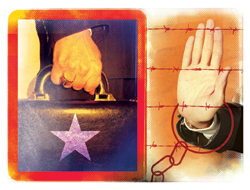Righting Wrongs

Illustration by Stuart Bradford
Recent amendments to the ABA model Rules of Professional Conduct instruct prosecutors that their ethics obligations require them to disclose evidence suggesting that a criminal defendant may have been wrongly convicted and to take steps to remedy a conviction when the evidence is clear and convincing.
The amendments to Model Rule 3.8 were approved in a voice vote by the ABA House of Delegates in February during the association’s 2008 midyear meeting in Los Angeles. There was no debate on the recommendation by the Criminal Justice Section and 10 co-sponsors.
“The rules are very simple,” said Stephen A. Saltzburg, a law professor at George Washington University in Washington, D.C., who chairs the Criminal Justice Section. “If prosecutors have new, credible evidence of innocence, they have to do something about it. It’s not a big burden.”
Saltzburg, who introduced the amendments in the House, acknowledged that they initially aroused concerns among prosecutors and the U.S. Department of Justice. But active opposition in the House failed to materialize after proponents of the amendments agreed to continue dialogue with the Justice Department and prosecutors to fine-tune the language of Rule 3.8 and the formal comments that accompany it.
“We’re going to keep a conversation going,” said Saltzburg in an interview after the House’s action. “There’s a number of things we might do.” He said the concerns of prosecutors were focused on specific language in the ethics rule amendments. But he said there is “total agreement” on the principles underlying the changes.
STATES TAKE CUES FROM ABA RULES
Amendments to the ABA model rules are not automatically adopted at the state level, where lawyer regulation takes place. But when the Model Rules are revised, state-level jurisdictions often consider changing their own professional conduct rules accordingly. Most states base their conduct rules on the ABA Model Rules, although often with variations.
In this case, the amendments to the ABA Model Rules regarding the duty of prosecutors are actually based on provisions adopted in 2006 by the New York State Bar Association, according to the Criminal Justice Section’s report to the House. The changes to the New York rules must be approved by the state’s high court, which is expected to consider them later this year.
Prior to being amended, ABA Model Rule 3.8 did not impose an explicit ethics obligation on prosecutors to disclose new evidence that a defendant may have been wrongfully convicted. Still, the duty is well-recognized, according to the Criminal Justice Section report. The obligation was articulated by the U.S. Supreme Court more than 30 years ago in its 1976 ruling in Imbler v. Pachtman. In addition, the ABA Standards Relating to the Administration of Criminal Justice state that prosecutors have a duty “to seek justice, not merely to convict.”
Under the amendments, as ratified by the House, a prosecutor must promptly disclose information to an appropriate court or other authority when he or she “knows of new, credible and material evidence creating a reasonable likelihood” that a convicted defendant did not commit the crime.
If the conviction was obtained in the prosecutor’s jurisdiction, the defendant must be informed and further investigation initiated. If the evidence is “clear and convincing,” the prosecutor must seek to remedy the conviction if it was obtained in his or her jurisdiction.
The Criminal Justice Section report cautions that the ethics duties of prosecutors should not be turned against them. “We are confident,” states the section, “that disciplinary authorities will not assume that prosecutors ignore substantial evidence of innocence and will not burden prosecutors with the need to respond to and defend ethics charges that are not supported by specific and particular credible evidence that the prosecutor violated his or her disciplinary responsibilities.”



